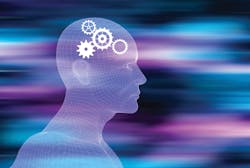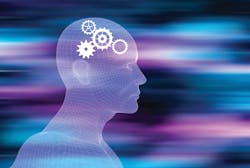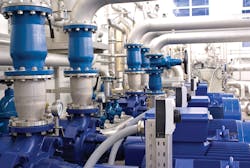Making the Most of Big Data
How machine learning, IIoT, and engineering models will revolutionize asset management in the water and wastewater industry
By Richard Irwin
The industrial world is awash with data from sensors, applications, equipment, and people. However, the data is worthless if it is left untouched or not used to its full potential to gain insights and make improved decisions. To make the most of big data, water and wastewater utility leaders should implement machine learning alongside the Industrial Internet of Things (IIoT) and use 3D visualization techniques to take advantage of the increased insight they can bring to the operation regarding performance and reliability.
Demystifying Machine Learning
As the velocity and variety of data becomes available through advancements in sensor technology to monitor just about anything, machine learning is being applied to efficiently manage increasingly large and fast-moving data sets. Machine learning can handle copious and complex information from sensors, mobile devices, and historians to discover hidden patterns or trends. It can then learn these patterns and apply them to new, real-time data to detect similar patterns in the future. Machine learning can be taught to identify what normal and abnormal behavior look like and, by applying the model to current data, it can identify events. The more data that is analyzed, the more accurate the predictive outcome.
The use of machine learning in water utilities doesn’t have to stop at demand and optimization; it can be applied across the entire operation where algorithms are used to continually improve overall performance across the whole facility and the equipment within it.
Machine Learning Techniques — Two Paths to Choose
Part of the implementation process is understanding how it works and the number of techniques involved. Your software service provider or machine learning expert will recommend what techniques to use and when. The most common techniques are:
Supervised machine learning: The program is trained on a predefined set of “test” data comprised of historical or similar data to the real thing, which then facilitates its ability to reach an accurate conclusion when provided with new data.
Unsupervised machine learning: The program is provided a mix of data and must find patterns and relationships without training or any specific target or outcome.
So, knowing what you want your data to tell you and what sort of data you have available are the most important factors in determining which path to choose.
Machine Learning Strategy — Questions to Consider
When implementing machine learning within your operation, certain details need to be considered regarding the data, the insights you are looking for, and how they can be applied within your business. Five questions to ask are:
1. Question your data: What aren’t you seeing that you hope the data can provide?
2. Clean your data: Is your data validated and can it be labeled easily?
3. Choose a platform: Have you considered interoperability?
4. Hire a data scientist: Do you have a machine learning engineer and can you collaborate with a subject matter expert?
5. Share the learning: Are you planning ahead to leverage the technology across the enterprise?
Staying Competitive
In the water utility industry, the ability to recognize equipment failure and avoid unplanned downtime, repair costs, and potential environmental damage is critical to success across all areas of the business because it directly affects the customer. This is even more relevant in today’s turbulent times affected by an aging asset infrastructure, demand, regulations, and higher costs. However, with machine learning, there are numerous opportunities to improve the situation. Some of the main forms of predictive analysis that machine leaning can deliver to the water industry include:
Predictive maintenance: This is one of the most applicable areas where machine learning can be applied within the water sector. Predictive maintenance can cover a large area of topics, from failure prediction and failure diagnosis to recommending mitigation or maintenance actions after failure. With the combination of machine learning and maintenance applications leveraging IIoT data to deliver more accurate estimates of equipment failure, the range of positive outcomes and reductions in costs, downtime, and risk are worth the investment.
Demand forecasting: Accurately forecasting high levels of demand, such as within a utility service, gives a company a competitive advantage. It provides the information needed to meet customer demand by anticipating future demand or consumption. Organizations can predict demand on any day or period in the future by using information such as historical demand data, regions, population, weather patterns, events, and so on. This ability is essential for ensuring that the utility can produce the required resource reliably and on time.
Smart meters: With the increasing use of smart meters in the home, water companies can now tap into the data provided by the IIoT to give a more accurate representation of usage by gaining more insight from individual habits. Machine learning helps ensure safe drinking water and can provide tailored insight on leak identification and water usage during water shortages to help curb waste.
In the water utility industry, the ability to recognize equipment failure and avoid unplanned downtime, repair costs, and potential environmental damage is critical to success across all areas of the business because it directly affects the customer.
Water distribution: Water utilities need a thorough distribution strategy for the continuous supply of water to its customers through a combination of balancing water resources and costs over varying time periods to meet levels of demand. Machine learning can be used in this scenario to speed up the decision-making process regarding demand by analyzing how much water is needed from various water sources, such as reservoirs and rivers. Additionally, machine learning can help determine pumping considerations and water movement, including associated costs and constraints.
Flood detection: During prolonged rain and runoff of rivers, floods can cause severe devastation to the environment and result in high cleanup costs. It is possible to detect rising water levels and fluctuation with a limited response time by using sensor data. Also, it can be difficult to discern whether a flood is in progress or whether there is a blockage somewhere in the system, which can lead to false alarms. Machine learning can handle a lot of data from sensors, weather, geospatial positioning, alarms, and more to give precise predictions and classifications on when and where floods are likely to occur.
With a machine learning strategy in place, plant operators gain unprecedented insight into their operations, leading to significant benefits in performance, efficiency, safety, and optimization, as well as increasing the speed with which decisions are made.
Bridging the Gap Between Real and Virtual
Engineering models, or digital twins, are the computerized 3D model version of the physical asset, which maps everything associated to the physical asset using sensors to represent nearly real-time status, such as condition, performance, and location. Where 3D models do not exist, you can quickly and easily produce them using 3D reality modeling software like Bentley’s ContextCapture. Photographs are transformed into detailed, comprehensive 3D models with associated infrastructure data — in a less labor-intensive, cheaper, and more efficient manner when compared to traditional methods.
IT/OT convergence has become an accepted practice, with operators gaining new insight from known information. But misalignment in corporate strategy still results in silo building across many areas. Designing and testing new products, systems, and even plants in a virtual environment makes for a compelling case, particularly from a cost perspective. Virtual models can tie these domains together over the whole lifecycle of an asset using its embedded digital DNA. From an asset management perspective, it’s about predicting a problem before it occurs and enabling maintenance to be performed at optimum rates and costs. This will be accelerated with the application of machine learning to make the decision-making process smarter, faster, and, more importantly, in context.
Continually modeling a network, or a plant, down to pumps and assemblies, means that personnel can survey the asset throughout its lifecycle, from initial design to current condition. Reality modeling can link engineers in the field directly to the office, sharing information and data collaboratively. Through IIoT data, together with the 3D models, the machine learning algorithms will provide even greater context, a predictive capability, and deliver more informed business insight, resulting in faster and more reliable decision making.
Digitalization and Machine Learning
Machine learning gives the user more intelligence, context, and insight to make the decision-making process easier and improve productivity. With a machine learning strategy in place, it will give you unprecedented insight into your operation and lead to significant benefits in performance, efficiency, safety, and optimization, as well as increase the speed with which decisions are made.
Summary
With the ability to acquire supplementary data, more advanced technologies are required to scrutinize and filter out the important information and the value held within. But, the information can only be utilized by identifying what works well and what does not. Machine learning features complex algorithms to sort through large amounts of data, identifying patterns and trends within it, to make accurate predictions.
The use of machine learning in water utilities doesn’t have to stop at demand and optimization; it can be applied across the entire operation where algorithms are used to continually improve overall performance across the whole facility and the equipment within it. By combining machine learning practices with IIoT and visual operations, significant benefits will be realized. Engineering models, IIoT and machine learning should no longer be considered as buzzwords. Instead, combining the three should be your priority for achieving operational excellence. WW
About the Author: Richard Irwin is senior marketing manager for AssetWise Amulet for Bentley Systems with over 10 years of experience in the analytics industry. He holds a master’s degree in sociology from Aberdeen University and a masters in IT from Heriot Watt, Edinburgh.
Circle No. 240 on Reader Service Card



